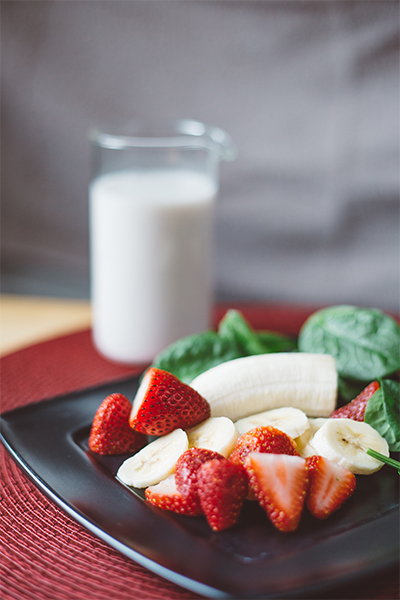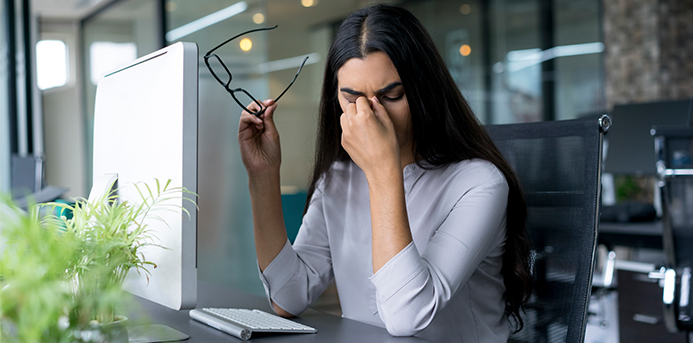You might aspire to finish out your work day strong, hit the the gym after the office, make a home-cooked dinner or have a spontaneous, mid-week outing with your family. But then that afternoon slump strikes between 3 and 5 p.m. — and take-out and pajama pants mount their mighty takeover.
The problem with that routine? All those goals and chores you hoped to accomplish during the week stack up, and get pushed into the weekend.
So, how do we reclaim our afternoon productivity and weeknight evenings?
We asked healthy-living experts to explain where we’re going wrong during the first half of day, and how we can self-correct so that we can have more energy through the home stretch.
Here are eight common energy zaps and strategies for overcoming them.
1. Being Mentally Scattered
The problem: A major energy drain happens throughout the day when we don’t manage our emotions and spend our energy on anxiety, worry and obsessive and non-productive thoughts, explains Morgan Sheets, a certified holistic well-being coach.
The fix: Set aside small appointments with yourself throughout the day, Sheets suggests. Take a one- to five-minute break a few times a day to quiet your mind, take a few deep breaths and center your body.
“This simple lifestyle change, when practiced regularly, will help you retrain your body from operating in the default mode of being stressed out, racing and feeling frenzied into a calm and peaceful state where you feel more energized,” Sheets says.
2. Not Drinking Enough Water
The problem: Dehydration is another common culprit for afternoon slumps. Sheets says people who work in an office environment tend to drink more soda and coffee during the day, and don’t drink as much water. However, both soda and coffee are dehydrating and don’t give your body the water it needs to function properly, which can cause you to feel tired at the end of the day.
The fix: To figure out how much water you need each day, divide your body weight in half and drink that many ounces of water. (i.e., if you weigh 150 pounds, you’ll want to drink at least 75 ounces of water per day). Sheets also recommends this simple strategy: For every cup of coffee, soda or alcoholic beverage you consume, add another glass of water.

3. Blood Sugar Spikes And Crashes
The problem: When our blood sugar levels crash, we feel tired, sluggish and irritable and want to just take a nap, explains Sheets.
The fix: Keep your blood sugar stable by eating smaller meals or snacks throughout the day and choosing foods and meals that are low on the glycemic index.
“Lower glycemic foods won’t cause dramatic spikes in your blood sugar, and they tend to provide more long-lasting energy,” Sheets says.
As a general rule, fat and fiber tend to lower the glycemic index (or “GI”) of a food. Also, the more cooked or processed a food is, the higher its “GI” tends to be, according to the American Diabetes Association. Some examples of low-glycemic foods include rolled or steel-cut oatmeal, sweet potatoes, corn, yam, peas, legumes, lentils, most fruits and non-starchy vegetables.

4. Sitting Under Fluorescent Lights
The problem: If you’re desk-bound, sitting in an office under fluorescent lights can certainly be an energy drain. Research shows that natural light and warmth can boost our productivity.
The fix: Take a walking meeting, suggests Marcey Rader, a productivity and health coach. They’re not only a great way to log some extra steps on your activity tracker, but they’re also good for the brain. The American Psychological Association conducted a study that found taking a walk can lead to more creative thinking than sitting.
Another trick courtesy of Rader: Queue up some up-tempo music that will wake you up during the afternoon slump.
“When I want to do something that requires energy, I have one to three songs like Pharrell’s ‘Happy’ or Pink’s ‘Rock Star’ that gets me motivated,” Rader says.
5. Being Sedentary At Work
The problem: It’s one of those bizarre facts of life: Sitting at a desk all day, just exercising our typing fingers, can leave us feeling wiped out at the end of the day. But why? It’s not like we competed in a triathlon. The brain actually uses a disproportionate amount of energy compared to other organs, so it really does take a lot of brain power to prepare reports and keep up with e-mail.
The fix: Get moving, suggests Parinaz Samimi, wellness expert for Medicare Health Plans. She recommends taking a walk around the block to re-energize as soon as you get home from work. At the very least, doing a little light yoga will energize your body. Try the forward bend followed by the downward dog, Samimi suggests. Or, try some “deskercise” if you can. Do some planks, sit-ups or push-ups right in your workspace.
“Anything that will get the body moving and the blood pumping will help you get some energy back and motivate you to get something done,” she says.
6. The Coffee Or Vending Machine Run
The problem: As it turns out, our body’s natural circadian rhythms slump mid-day. For most people this occurs around 2 to 3 p.m. It’s also called the “siesta period.” While it may feel good in the moment to grab a Diet Coke or a Venti Caramel Macchiato, this can actually set you up for another slump at the end of the day, explains Samimi.
“Getting off work can cause a major let-down in energy, especially if it has been a difficult day or you’ve had caffeine to try and wake up,” she says.
The fix: Resist caffeine during the “siesta period.” It’s tempting to turn to it to get over the slump, but it can make you crash later and disrupt your sleep at night, which creates a vicious cycle. To help fend off the notorious afternoon energy slump, Samimi recommends eating lighter foods at lunch like a healthy sandwich or salad with fruit instead of a heavy pasta dish.

7. You’re Not Sleeping Enough
The problem: Adults age 18 to 64 need seven to nine hours of sleep each night, according to the National Sleep Foundation. For those 65 and up, the recommendation is seven to eight hours of ZZZs each night. When you don’t get enough, queue the daytime yawns.
The fix: To help get enough sleep each night, practice a bedtime routine, suggests Chris Brantner, a certified sleep science coach who works with SleepZoo. Our bodies crave routines, so creating one near bedtime can help you unwind. This might include shutting off devices, dimming lights, sipping warm tea or taking a bath. Also, he says, be careful with naps. If you take one, be sure it’s short and in the early afternoon.

8. Your Lunch Isn’t Balanced
The problem: Simply put, your cells need energy and they get it from the food you eat, explains Karen Bernstein Shoshana, who is certified in functional diagnostic nutrition and the founder of Wellness Girl. When you eat refined sugar, you get a rush of energy — that ultimately leads to a blood sugar crash. (We’re wagging our fingers at you, bagels, doughnuts and crackers!)
The fix: Make sure your lunch is balanced with fat and protein, she says. That will help slow the sugar (i.e., glucose) as it makes its way into your cells. Make this your lunch-time mantra: “Fat-fiber-protein,” suggests Shoshana. She shares an example of a meal that will fill you up and carry you through the afternoon: mixed greens with half a diced avocado, sliced turkey, diced beets, a sprinkle of sea salt and drizzle of olive oil.
Written by Brittany Anas for Simplemost.

